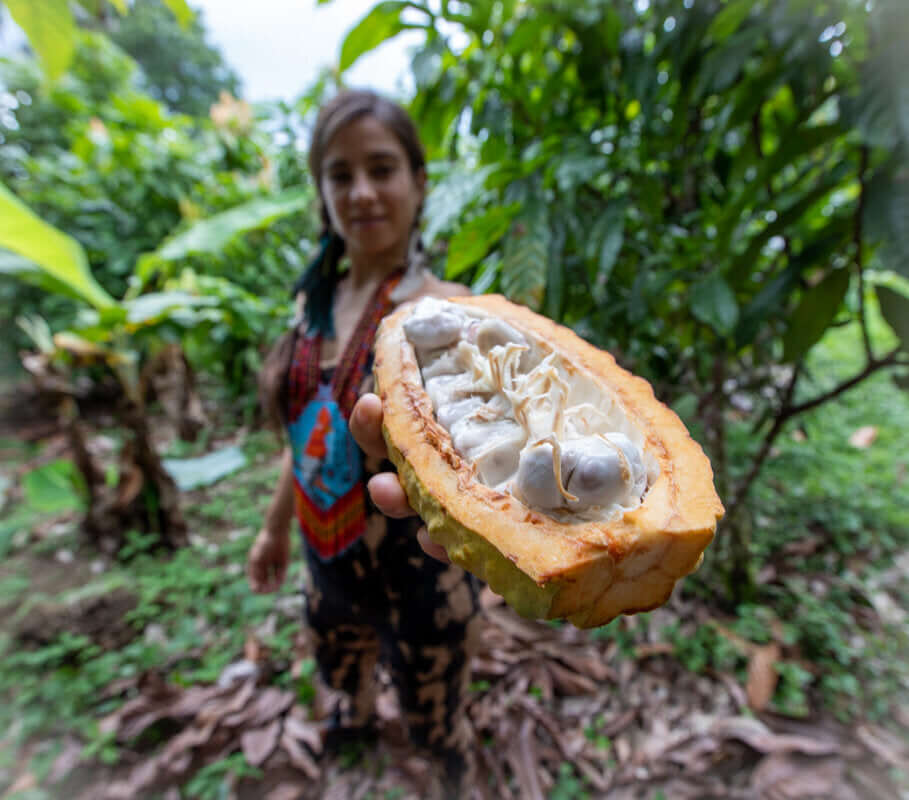
Arriba Nacional is one of the most beloved types of Cacao, favored by chocolate makers and Cacao enthusiasts alike. It is endemic to Ecuador and is a source of pride for Ecuadorian farmers. Here we get to know this delicate strain of Cacao through its history and cultural context.

The origins of Arriba Nacional Cacao
Urban legend surrounding the origin of the Ecuadorian Cacao known as Arriba Nacional has its roots in the early days of Cacao trade. When producers were asked where their Cacao was from, the answer was always, "Cacao de arriba," which translates to "from up the river". Eventually, this evolved to Cacao de Arriba Nacional and subsequently Arriba Nacional. Arriba Nacional is what's known as a criollo strain. Criollo Cacao (criollo translates to "native" in Spanish, and is often used in relation to native strains of Cacao) is praised as the most flavorful cacao in the world; some say it's the healthiest, as well.
"Cacao was traditionally classified into two major groups: Criollo and Forastero (Cheesman 1944). Criollo Cacao was cultivated by pre-Columbian people from Mesoamerica, where it was introduced from southwestern Venezuela and northeastern Colombia. Criollo has a narrow genetic background resulting from a single process of domestication (Cornejo et al. 2018; Motamayor et al. 2002), and while Criollo beans are superior in quality, the trees are susceptible to diseases (Cuatrecasas 1964). Forastero refers to all other forms of Cacao, and inherently has a more diverse genetic background." [APSJournals]
The word Nacional stems from the sense of pride with which Ecuadorians regard their national variety of Cacao. Recent findings from a study of the Cacao genome show that the plant was first domesticated in the Amazonian basin, which includes modern-day Ecuador. The findings conclude that Cacao was actually traded north through the Pacific routes to modern-day Guatemala, Belize and Mexico from the Amazon, and not the other way around, as has been commonly held for most of post-Columbian history. Arriba Nacional is believed to be one of the aboriginal strains and one of the first to be domesticated.
Nacional Cacao receives a devastating blow
The superior quality and taste of Ecuadorian Cacao and its Criollo strains became well-known in the 19th and 20th centuries, propelling Ecuador to one of the top spots in Cacao production. Like all crops, however, Cacao is subject to pests and disease. The chances of a crop falling victim to the elements increases with crop size. Criollo is particularly delicate, making it far more susceptible to malady. In particular, two plant diseases, Moniliophthora roreri and Moniliophthora perniciosa, nearly decimated the country’s entire Cacao population. The impact on the industry was devastating.

"The complications began about a hundred years ago. In the late 1800s and early 1900s, it is surmised that all cacao grown in coastal Ecuador was 100% genetically-pure Nacional[1]. Starting in 1916, there was a back-to-back outbreak of two plant diseases (Frosty Pod and Witches’ Broom), which infected cacao across the country. Production was crippled. Foreign cacao varieties, initially in the Trinitario[2] family of cultivars, were subsequently introduced to Ecuador in response to this crisis." [Toak]
Later in the century, agronomists crossbred different varieties of Cacao and created strains that were highly productive and resistant to disease. Unfortunately, these varieties were bred for productivity and not flavor. The crossbreeding was a modification of the native strains, increasing survivability while diminishing quality and taste. For this, the Ecuadorian Cacao market suffered. The diminished quality of the new Cacao crops reflected poorly on the once renowned fruit. And as the reputation of their beans plummeted, so did its sales.
Ecuadorian heirloom Cacao makes its comeback
In the intervening years, much has been done to recover the greatness of Ecuadorian Cacao. The country has regained its position as one of the world's largest Cacao exporters. With great effort from scientists, farmers, and preservationists, Cacao in Ecuador has begun to rise in quality and flavor.
While much of what Ecuador currently produces is a hybrid strain called CCN-51, a heartier strain of Cacao that resists pests and climatic events much better than the delicate Nacional strain, there are still heirloom growths of Nacional Cacao trees in select regions of Ecuador. While these CCN-51 Cacao plants are not necessarily bad, their quality pales in comparison to pure Nacional. That is why we have made it our mission to seek out the very limited but very high-quality Nacional Cacao crops in the Manabí region of Ecuador—one of the few regions still maintaining the timeless quality that made Ecuador the premier Cacao producer in the first place.
